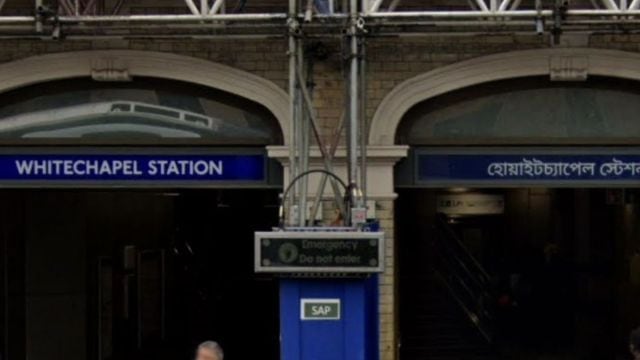English Vinglish and Elon Musk: The quest for a whitewashed London that never existed (original) (raw)
 Rupert Lowe, the Great Yarmouth MP, took to his official X account and posted a picture of the dual language signboard at the Whitechapel Station.(X/@Rupertlowe10)
Rupert Lowe, the Great Yarmouth MP, took to his official X account and posted a picture of the dual language signboard at the Whitechapel Station.(X/@Rupertlowe10)
Feb 12, 2025 15:10 IST First published on: Feb 12, 2025 at 13:52 IST
Kurtas, salwar, imitation jewellery, gol gappe, jackfruit hanging from hooks. Is this Sarojini Nagar market? The thought may fleetingly strike you before beating just as sudden a retreat when you see the prices. It’s Whitechapel in London, nowadays known more for jalfrezi than Jack the Ripper. You’ll see one of the biggest mosques in Western Europe, and a bit further down the road, an underground — literally — Somalian restaurant with Old Delhi vibes where you can eat something biryani-esque off a shared plate. There’s the proverbial Brick Lane and, perhaps inevitably, a fish-and-chip shop called Jack the Chipper.
In this cultural khichdi, there’s nothing particularly out of place about a sign displaying the local tube station’s name in both English and Bengali. Nor is there anything surprising about an MP from Nigel Farage’s Reform Party complaining about it. Elon Musk sticking his oar in is practically a given. On the surface, there’s the old debate of integration versus multiculturalism — should minority groups assimilate fully into the dominant culture, or can these cultures thrive alongside each other? But what’s interesting here is the deeper cultural politics underlying it — that of the British, or rather, English right’s war on London. Think Londonistan, add a couple more decades of anti-immigrant, anti-multicultural politics culminating in Brexit, and the knotty question of English-versus-British identity.
Story continues below this ad

Set against the nativist imagination is London’s historical reality: That of a bustling port city that has always hosted travellers from across the oceans, some of whom settled down — from the legionaries and traders coming from the Mediterranean region, who rubbed shoulders with the Britons in Roman Londinium, to the Jewish and Lombard merchants of the Middle Ages to the East India Company’s lascars. There were those who played important roles in British society and politics, from William Cuffay, the son of a formerly enslaved Black man from the West Indies and an Englishwoman, who settled in London and became a leader of the Chartist movement in the mid-19th century, to myriad Irishmen and women of all social strata. Whitechapel and East London more broadly have their own history of working-class Irish immigrants who came in the wake of the Potato Famine, as well as Eastern Europeans and Russian Jews — all of whom contributed to the melting pot before the Bangladeshis.
The 19th century saw London transform itself from the mercantile capital of Napoleon’s “shopkeepers” to a self-consciously imperial city, full of mushrooming monuments fit to bear the White Man’s Burden; the detritus of empire is strewn all about today. And attendant on being an imperial centre was a certain cosmopolitanism — as it was in Rome, Constantinople or Delhi for that matter, so it was in London. After this came the great waves of post-imperial migration that shaped the demography and debates of today. London has hardly ever been 100 per cent White and English — so English nationalism seeks a whitewashed, homogeneous London that never really existed. The imperial nostalgia that sometimes accompanies such nationalism conveniently elides imperial cosmopolitanism. It’s a contradiction; you can’t have both Little England and Great Britain at the same time.
This tension has a parallel in people’s self-identification — whether they see themselves as more “English” or “British”. A 2018 BBC survey found that 61 per cent of people who described themselves as White “were proud to declare their English identity”, whereas the figure for those from ethnic minority groups was only 32 per cent. On the other hand, three-quarters of the BME (Black and Minority Ethnic) population strongly identified as British. “The English identity emerges as more exclusive while the British identity is seen as more inclusive. Among those who call themselves English rather than British, only a third say the country’s diversity is an important part of their identity. Among those who describe themselves as more British than English, the figure is two-thirds,” the survey added. If you grow up in England as the child of immigrants, can you really be English? It depends on who you ask.
Story continues below this ad
Such an exclusive vision of the nation would struggle to swallow a multicultural, British London. Therefore, the latter’s history must be erased, its diversity smoothed out and its many tongues cut out if it is to be the capital of England (not Britain).